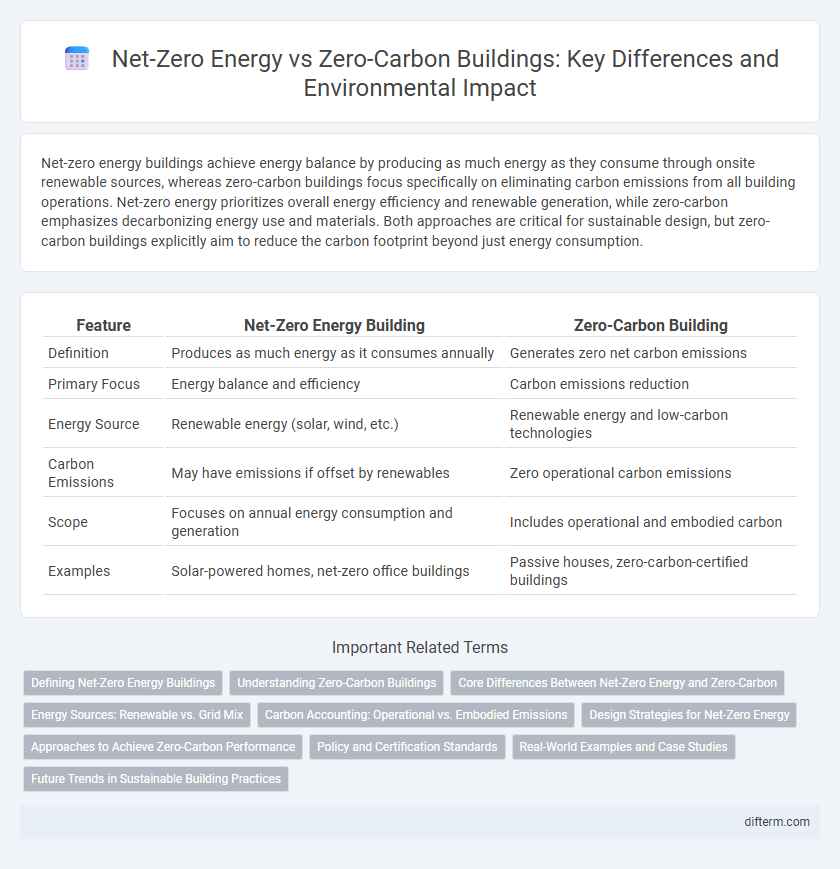Net-zero energy buildings achieve energy balance by producing as much energy as they consume through onsite renewable sources, whereas zero-carbon buildings focus specifically on eliminating carbon emissions from all building operations. Net-zero energy prioritizes overall energy efficiency and renewable generation, while zero-carbon emphasizes decarbonizing energy use and materials. Both approaches are critical for sustainable design, but zero-carbon buildings explicitly aim to reduce the carbon footprint beyond just energy consumption.
Table of Comparison
| Feature | Net-Zero Energy Building | Zero-Carbon Building |
|---|---|---|
| Definition | Produces as much energy as it consumes annually | Generates zero net carbon emissions |
| Primary Focus | Energy balance and efficiency | Carbon emissions reduction |
| Energy Source | Renewable energy (solar, wind, etc.) | Renewable energy and low-carbon technologies |
| Carbon Emissions | May have emissions if offset by renewables | Zero operational carbon emissions |
| Scope | Focuses on annual energy consumption and generation | Includes operational and embodied carbon |
| Examples | Solar-powered homes, net-zero office buildings | Passive houses, zero-carbon-certified buildings |
Defining Net-Zero Energy Buildings
Net-zero energy buildings are designed to produce as much energy as they consume annually through on-site renewable sources like solar panels and wind turbines, achieving a balance between energy input and output. These buildings emphasize energy efficiency and integration of clean energy systems to minimize reliance on external fossil fuel-generated power. Unlike zero-carbon buildings that focus solely on avoiding carbon emissions, net-zero energy buildings prioritize overall energy self-sufficiency and sustainability in their design and operation.
Understanding Zero-Carbon Buildings
Zero-carbon buildings eliminate all carbon emissions associated with their energy use by relying entirely on renewable energy sources or offsetting any remaining emissions through carbon credits. These buildings prioritize materials and construction processes with minimal embodied carbon, ensuring that both operational and embedded emissions are addressed. Achieving zero-carbon status demands comprehensive energy efficiency measures, innovative design strategies, and integration of clean technologies such as solar panels and geothermal systems.
Core Differences Between Net-Zero Energy and Zero-Carbon
Net-zero energy buildings produce as much energy on-site through renewable sources as they consume annually, focusing on balancing energy demand with clean energy generation. Zero-carbon buildings prioritize eliminating carbon emissions entirely, which may involve purchasing carbon offsets or using carbon-free energy sources, even if energy consumption exceeds production. The core difference lies in net-zero energy emphasizing energy balance, while zero-carbon centers on total carbon emissions reduction regardless of energy source or quantity.
Energy Sources: Renewable vs. Grid Mix
Net-zero energy buildings achieve balance by producing as much renewable energy on-site as they consume annually, relying heavily on solar, wind, or geothermal sources. Zero-carbon buildings primarily focus on eliminating carbon emissions, often depending on a clean grid mix that includes renewables alongside nuclear or hydroelectric power. The distinction lies in energy sourcing: net-zero mandates self-generated renewables, while zero-carbon permits wider grid decarbonization strategies.
Carbon Accounting: Operational vs. Embodied Emissions
Net-zero energy buildings balance the energy they consume with renewable energy produced on-site, primarily addressing operational emissions from heating, cooling, and electricity use. Zero-carbon buildings emphasize eliminating carbon emissions throughout the building's lifecycle, including both operational emissions and embodied carbon from materials and construction processes. Comprehensive carbon accounting integrates these distinctions, ensuring accurate measurement and strategies for reducing total greenhouse gas emissions in the built environment.
Design Strategies for Net-Zero Energy
Design strategies for net-zero energy buildings prioritize maximizing energy efficiency through high-performance insulation, airtight construction, and advanced glazing systems to reduce heating and cooling demands. Integration of renewable energy technologies like solar photovoltaic panels and geothermal systems ensures onsite energy generation meets or exceeds consumption. Smart energy management systems and passive design principles further optimize building performance, enabling net-zero energy targets without solely relying on carbon offsets.
Approaches to Achieve Zero-Carbon Performance
Net-zero energy buildings achieve zero-carbon performance by generating as much renewable energy on-site as they consume annually, primarily through solar panels and energy-efficient systems. Zero-carbon buildings prioritize eliminating carbon emissions entirely, often relying on clean energy procurement, advanced insulation, and electrification of heating and cooling systems powered by renewable sources. Both approaches emphasize reducing operational carbon footprints, with zero-carbon strategies extending to embodied carbon reduction through sustainable materials and construction practices.
Policy and Certification Standards
Net-zero energy buildings achieve a balance between energy consumed and energy produced onsite, often guided by the International Living Future Institute's Net Zero Energy Certification or the U.S. Department of Energy's Zero Energy Ready Home program. Zero-carbon buildings eliminate carbon emissions by relying on renewable energy and offset mechanisms, with certifications like the CarbonNeutral(r) Standard or LEED Zero Carbon providing frameworks for compliance. Policy frameworks such as the European Green Deal and California's Title 24 emphasize integrating these standards to drive sustainable building practices and reduce environmental impact.
Real-World Examples and Case Studies
Net-zero energy buildings, such as the Bullitt Center in Seattle, produce as much energy as they consume annually through onsite renewable sources, integrating solar panels and energy-efficient systems to minimize environmental impact. Zero-carbon buildings like the Edge in Amsterdam offset their carbon emissions entirely by combining renewable energy use with carbon credits, demonstrating scalable urban sustainability strategies. Case studies from both show how energy-efficient design and renewable technologies can significantly reduce operational energy demand while addressing carbon emissions in practical settings.
Future Trends in Sustainable Building Practices
Net-zero energy buildings generate as much energy as they consume annually, relying heavily on renewable energy sources and advanced energy efficiency technologies, while zero-carbon buildings aim to eliminate carbon emissions through sustainable materials and carbon offset strategies. Future trends emphasize integrated smart grid systems, enhanced building envelope designs, and widespread adoption of on-site renewable energy production to push beyond net-zero achievements towards carbon negativity. Innovations in energy storage, real-time energy monitoring, and regulatory incentives are accelerating the transformation of both net-zero energy and zero-carbon building practices globally.
Net-zero energy vs Zero-carbon building Infographic

 difterm.com
difterm.com